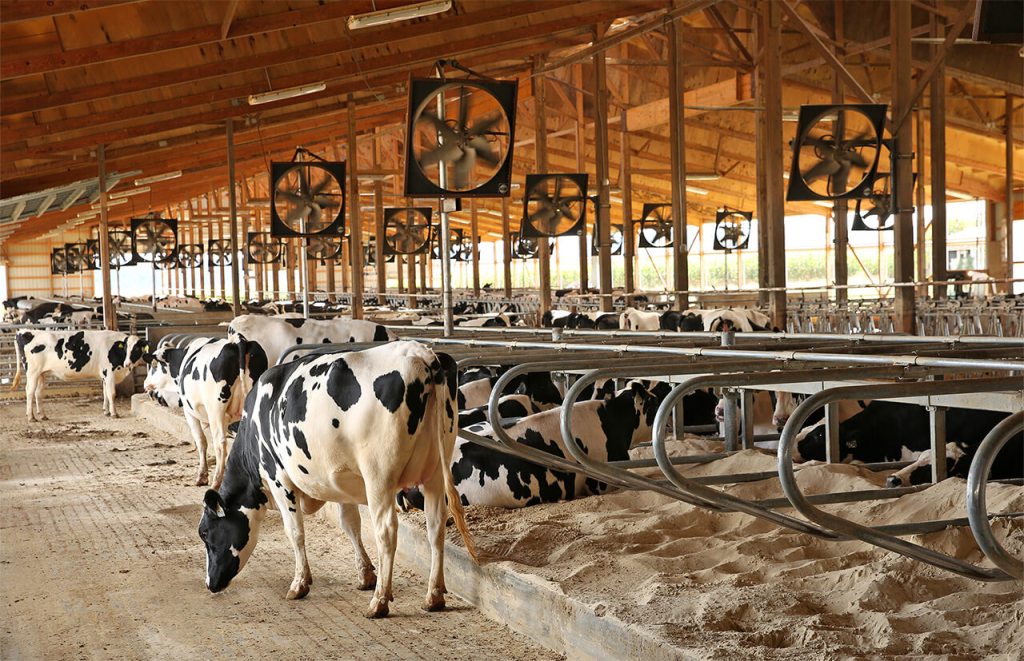Written by Anibal Ballarotti for Progressive Dairy, U.S. 🇺🇸
Dairy farming has become an increasingly complex activity today, mostly due to its multidisciplinary demands. It is essential for dairy farmers and their advisers to take a broad 360-degree view of the business.
In the Information Age there are many sources of data available to farmers and advisors, yet they sometimes struggle to integrate all the factors related to success: fertility, genetics, milk production, nutrition, housing, health and so on. Consultants may go into deep detail on the benefits of an extra hormone injection in a timed-A.I. program or adding some protected amino acids in the diet formulation. However, they might overlook other more basic factors, such as access to clean water, food or bed quality.
Maybe because of herd sizes growing from hundreds of cows in small to medium-sized dairies, to thousands of cows in huge operations, we run the risk of failing to consider simple but essential factors in this complex system: The cows themselves. If the cows could talk, they may very well tell us what their needs are for happy (and productive) lives. If we fail to take the time to look carefully at the cows and try to assess their lives through their own eyes, we may miss important clues essential to a healthy, happy and productive herd.
Fortunately, there are technologies and animal monitoring systems such as Cow Signals and others available to help us do precisely that. These systems establish our point of reference with a simple question: Are we providing the basic needs of cows? Essentially, we must provide air, light, space, food, water and rest to establish good health in a dairy cow. These needs may seem easy to meet. But are we overlooking the obvious?
At the most basic level, simply spending some time observing cow behavior in the barn can be a strong indicator of whether or not those basic needs are being achieved. When not going to the milking parlor, a happy cow likes to eat, drink, rest and take time to walk around and socialise. If she is not doing any of these four things, but rather is just standing and waiting passively, she could be telling us something is wrong. Some basic need has not been met. With that in mind, we can dive into these needs and what simply looking at and listening to our cows can tell us about them:
1. Air: Cows want maximum fresh air and ventilation.
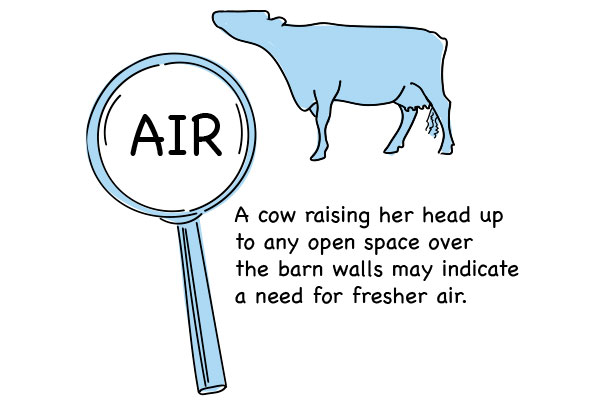
A cow raising her head up to any open space over the barn walls may indicate a need for fresher air. Lactating cows increase their body temperature considerably. To get rid of this excess temperature they primarily increase their rate of breathing. They try to cool themselves by remaining standing, instead of lying down. Standing makes respiratory movements easier. Sometimes they raise their upper body above their posterior part to make respiration even easier. The optimal temperature for lactating cows is 15 to 60º F. Below 40ºF, they need extra energy to stay warm. Depending on the humidity, over 70ºF cows start showing the first signs of stress.
2. Light: Cows with optimal milk production and fertility like to have 14 to 16 hours of light per day and six to eight hours of darkness.

Dry cows and heifers near calving like 8 hours of light and 16 hours of darkness. Light means 200 lux on cow level everywhere in the barn. You may verify this level by using a light meter, or a simple test is to see if you can read a newspaper any place in the barn. Dark means 50 lux or less, which is perceived as night by cows. Darkness can change their circadian cycle, possibly decreasing signs of heat. If we are not providing enough light or air, we need to consider breaking down walls, adding more windows or installing additional electric lights.
3. Space: A happy cow has free access to food, water and bed.
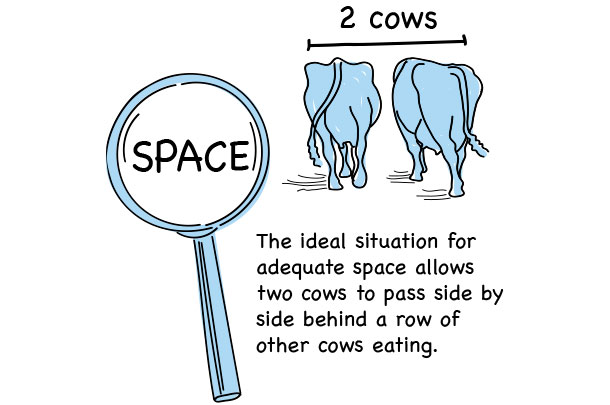
They need to be able to move freely around. They should be able to walk through the group without touching each other. They need to be able to retreat to a safe place in the event of some conflict or hierarchical issue. For instance, the dominant cows typically eat first, which can create an important obstacle to the subordinated ones. So besides good feet, good legs and good grip to the floor, they need space. This essential free movement is not possible in an overcrowded group. The ideal situation would allow two cows to pass side by side behind a row of other cows eating.
4. Food: Happy cows should be able to access the feed alley safely 24 hours per day, with enough space to eat in a relaxed manner
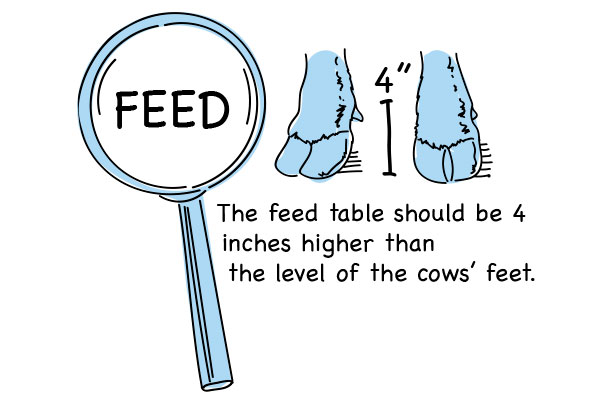
One spot per cow would make an ideal feeding environment. Cows are herd animals, thus, they like to eat at the same time. Grouping first-lactation cows separately from those with multiple lactations will result in higher productivity. That is because primiparous cows are generally subordinated, and, when separated, they will eat in a more relaxed fashion. They typically visit the feed alley more often and consume smaller portions but may have a higher dry matter intake. The feed table should be 4 inches higher than the level of the cows’ feet. If higher than this, cows will eat with a horizontal head position and will chew less and produce less saliva.
5. Water: Unlimited access to fresh drinking water is as important as having enough fresh food.
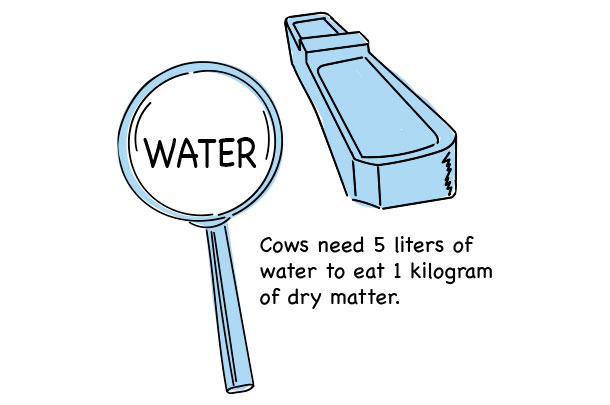
Cows need 5 liters of water to eat 1 kilogram of dry matter. Animals like to drink the cleanest, freshest water available. They also like to drink immediately after being milked. Thus, waterers should be in multiple positions close to the feed alleys. As a rule of thumb, there should be one big water source for every twenty cows, or one smaller supply for every ten cows. A cow drinks six to eight times a day, up to 20 liters at a time. Dirt at the bottom of the tanks will give the water an unpleasant taste. Bacteria will grow, causing the water to stink. This poses a danger to animal health. Empty water tanks daily and clean them deeply once a week.
6. Rest: Happy cows like to lie down on a soft and grippy bed floor.
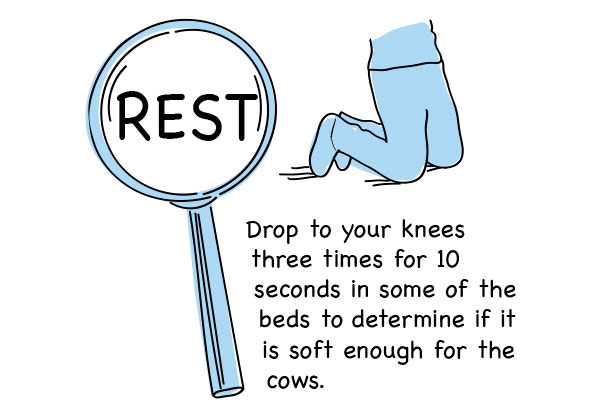
Softness prevents front knee and hock damage. Good grip prevents slipping and sliding and backbone and hock damage. Cows standing and waiting are not lying down because they are not comfortable. What message does this send the dairy manager? The cows are saying they fear hurting themselves on the available beds. Provide every cow with at least one soft, deep bed, using sand or other soft material as bedding. Clean the beds at least 3 times daily and fill them weekly.
To check if beds are dry and comfortable, you can do the “knee test.” Drop to your knees three times for 10 seconds in some of the beds to determine if they are soft enough for the cows. In addition, the “back-of-hand-rub test” tells us if the beds are too abrasive to the cow’s hocks. If you have a barn needing improvement, begin reconstruction as soon as possible. Suggest an adaptation of 10 beds accordingly, and let the cows convince the producer.
Conclusion
Providing optimal cow comfort through these six basic needs of cows in freestalls is not easy. But adjusting any system to address the deficiencies about which the cows themselves are telling us, will improve the dairy. If we learn how to focus on providing fresh air, light, space, and maximum opportunities to eat, drink and rest, the outcome will be an environment that promotes production, health and cleanliness, while minimising wounds, lesions and lameness.
A healthier cow is happier. The next time you approach the herd you can exchange knowing looks with the cows, because you have heard what they are telling you.
Originally published on Progressive Dairy



